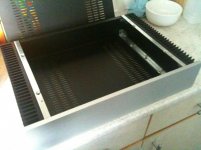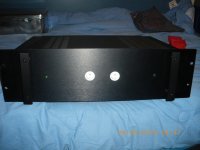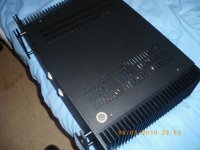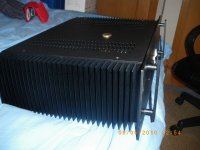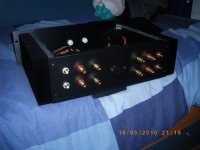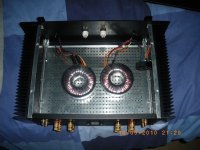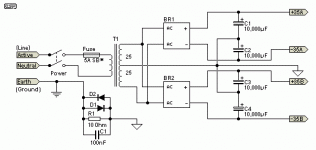Uriah,
I'm glad to see you got an amp built and it sounds good. It will only get better over the first few dozens of hours.
I think your hum might be addressed by some better wire dressing and routing. The standard circuit is not prone to hum. My amps have no hum whatsoever, and I have not used any extraordinary grounding methods. Try twisting the input wires. My input caps are directly next to the PCB, almost touching it, and my input jacks are directly next to that. Total lead length from jack to cap and cap to board is only 3 or 4 inches. With longer leads such as yours, hum could find a way in.
I have not yet ordered kits or boards. Will there be some available?
Peace,
Tom E
I'm glad to see you got an amp built and it sounds good. It will only get better over the first few dozens of hours.
I think your hum might be addressed by some better wire dressing and routing. The standard circuit is not prone to hum. My amps have no hum whatsoever, and I have not used any extraordinary grounding methods. Try twisting the input wires. My input caps are directly next to the PCB, almost touching it, and my input jacks are directly next to that. Total lead length from jack to cap and cap to board is only 3 or 4 inches. With longer leads such as yours, hum could find a way in.
I have not yet ordered kits or boards. Will there be some available?
Peace,
Tom E
Uriah,
I'm glad to see you got an amp built and it sounds good. It will only get better over the first few dozens of hours.
I think your hum might be addressed by some better wire dressing and routing. The standard circuit is not prone to hum. My amps have no hum whatsoever, and I have not used any extraordinary grounding methods. Try twisting the input wires. My input caps are directly next to the PCB, almost touching it, and my input jacks are directly next to that. Total lead length from jack to cap and cap to board is only 3 or 4 inches. With longer leads such as yours, hum could find a way in.
I have not yet ordered kits or boards. Will there be some available?
Peace,
Tom E
Could you post a picture?
How will you not have hum if you have speaker outputs running so close to the toroidal? Making turns or partial turns around it will induce 60Hz voltage into the output. The more the turns, the mores the voltage you have.
Like some said before, when you tidy all up induced noise will be reduced (as long as you do wiring in a proper way).
As a polling purpose for all builders: Are you going to tie GND from the amp to Protective Earth, as all regulation agencies and safety certifications oblige? That is NOT an optional decision when you talk about final prototypes.
Regards,
Regi
Like some said before, when you tidy all up induced noise will be reduced (as long as you do wiring in a proper way).
As a polling purpose for all builders: Are you going to tie GND from the amp to Protective Earth, as all regulation agencies and safety certifications oblige? That is NOT an optional decision when you talk about final prototypes.
Regards,
Regi
Last edited:
I got a chassis from the guy who makes the lampucera DACs on ebay about one year ago. Total cost shipped was around $100 (I think). This included IEC Plug, Fuse holder, RCA Jacks and Banana Jacks. I have emailed him to see if he has any more of the chassis and the price.
This is my build with a lm3886 from chipamp.com:

This is a photo the seller uses on ebay. I think this photo is taller than my chassis, but the general look is the same. I think mine is acually a POA-200:
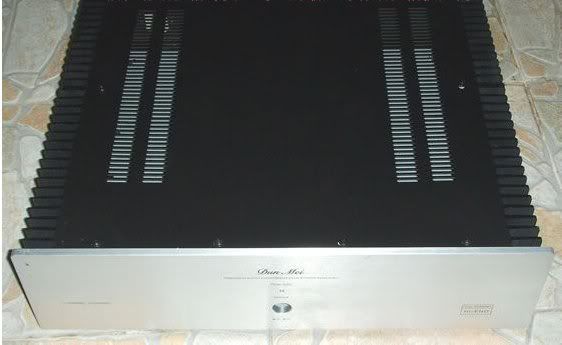
This is my build with a lm3886 from chipamp.com:

This is a photo the seller uses on ebay. I think this photo is taller than my chassis, but the general look is the same. I think mine is acually a POA-200:

Hey, if you are going to presume of high end enclosures, I cannot keep quiet 
Shark, I really love the 2U case you have from modushop. I went for a similar one, but it is 3U tall and I preferred the rack-mount front panel. It gives it a more professional look IMHO, some kind of industrial look like the ones that you can see at concerts and workplaces. Your's is more refined, but without loosing a bit of solidness.
Here is my anxious-waiting enclosure. It really NEEDS to be filled now
Shark, I really love the 2U case you have from modushop. I went for a similar one, but it is 3U tall and I preferred the rack-mount front panel. It gives it a more professional look IMHO, some kind of industrial look like the ones that you can see at concerts and workplaces. Your's is more refined, but without loosing a bit of solidness.
Here is my anxious-waiting enclosure. It really NEEDS to be filled now

Attachments
Regi,
The safety grounding issue has been discussed before. It has been stated that the amp ground does not need to be connected to earth ground, for safety or for any other reason. That is where a lot of trouble with hum enters the picture.
If the incoming mains safety ground is connected to a ground lug SECURELY fastened to the metal enclosure, it should make this amp safe. And that is the ONLY conductive element that should be touching any part of a metal enclosure. If there are hum issues, it is usually caused by accidentally grounding some other point in the signal path, or by routing wires incorrectly or dressing them poorly, or from some other point upstream of the amp, such as a volume control or switch not insulated from the enclosure.
I ran my amps for months without a cover on the enclosure, with the input jack and input cap hanging by the signal wires over the edge of the enclosure (not recommended!). The amps sat under a big screen TV and were moved into and out of various systems, next to other amps, and so on, all without ever producing a whisper of hum. The power transformer inside each monoblock sits only an inch or two away from the PCB, with short input and short output leads routed away from it.
Peace,
Tom E
The safety grounding issue has been discussed before. It has been stated that the amp ground does not need to be connected to earth ground, for safety or for any other reason. That is where a lot of trouble with hum enters the picture.
If the incoming mains safety ground is connected to a ground lug SECURELY fastened to the metal enclosure, it should make this amp safe. And that is the ONLY conductive element that should be touching any part of a metal enclosure. If there are hum issues, it is usually caused by accidentally grounding some other point in the signal path, or by routing wires incorrectly or dressing them poorly, or from some other point upstream of the amp, such as a volume control or switch not insulated from the enclosure.
I ran my amps for months without a cover on the enclosure, with the input jack and input cap hanging by the signal wires over the edge of the enclosure (not recommended!). The amps sat under a big screen TV and were moved into and out of various systems, next to other amps, and so on, all without ever producing a whisper of hum. The power transformer inside each monoblock sits only an inch or two away from the PCB, with short input and short output leads routed away from it.
Peace,
Tom E
Yeah Tom, I have another amps too without cover neither. One of them has a piece of carton hanging on top. That are suicidal ideas that I don't recommend anyone to do.
But what happens if the live touch an rca by any way, and someone touch it? Or the binding posts? That are conductive parts too, so I will put them to ground. It can be done without injecting noise from earth, by a simple device formed by only a diode bridge, a 0.1 capacitor and a 10 ohm resistor. I am sure that it works as it is supossed, I have earthed in that way all my sound chain and it is silent as dead with my speakers at max, it is a gainclone.
But that are my preferences, I like that everyone choose is own approach to this issues. Excepting the rca and the binding posts security issues, it should work quite well with the metal enclosure only tied to protective earth. Other of my gear is assembled that way.
Regards,
Regi
But what happens if the live touch an rca by any way, and someone touch it? Or the binding posts? That are conductive parts too, so I will put them to ground. It can be done without injecting noise from earth, by a simple device formed by only a diode bridge, a 0.1 capacitor and a 10 ohm resistor. I am sure that it works as it is supossed, I have earthed in that way all my sound chain and it is silent as dead with my speakers at max, it is a gainclone.
But that are my preferences, I like that everyone choose is own approach to this issues. Excepting the rca and the binding posts security issues, it should work quite well with the metal enclosure only tied to protective earth. Other of my gear is assembled that way.
Regards,
Regi
That will give yours a nice and practical touch.Very nice regiregi22,You are spot-on it is a 2U case from modushop.biz very nice cases ,I went for the milled handles not fitted yet....
What I love most of mine are the holes in both ends to place it in a rack
....Regi,
The safety grounding issue has been discussed before. It has been stated that the amp ground does not need to be connected to earth ground, for safety or for any other reason. That is where a lot of trouble with hum enters the picture.
If the incoming mains safety ground is connected to a ground lug SECURELY fastened to the metal enclosure, it should make this amp safe. And that is the ONLY conductive element that should be touching any part of a metal enclosure. If there are hum issues, it is usually caused by accidentally grounding some other point in the signal path, or by routing wires incorrectly or dressing them poorly, or from some other point upstream of the amp, such as a volume control or switch not insulated from the enclosure.......
Peace,
Tom E
Absolutely agree. And do all of mine in that fashion.
However Mr. pass does sometimes tie the signal grd to chassis grd through a CL-60.
Oh dont get so worried about my wiring and case. It shouldnt be perfect right now anyway. I have yet to finish messing with it.
The hum was what you thought Tom. Signal wire was on top of power supply caps on other channel. As soon as I touched it the hum stopped.
As for the Sonance I just removed the guts and drilled a few holes.
Uriah
The hum was what you thought Tom. Signal wire was on top of power supply caps on other channel. As soon as I touched it the hum stopped.
As for the Sonance I just removed the guts and drilled a few holes.
Uriah
Hi Regi & Madison,
The chassis must be permanently connected to the Safety Earth. No choice.
All exposed conductive parts must be connected to Safety Earth.
Madison. Where did you see?
We are not competent to design and build and test and guarantee the safety of ClassII devices. We must build Safety Earthed devices. No choice.
Do not bother with a poll on unsafe practice. I will talk to the Moderators with the purpose of shutting it down.
The chassis must be permanently connected to the Safety Earth. No choice.
All exposed conductive parts must be connected to Safety Earth.
Madison. Where did you see?
It is completely wrong and it is dangerous.It has been stated that the amp ground does not need to be connected to earth ground, for safety or for any other reason.
We are not competent to design and build and test and guarantee the safety of ClassII devices. We must build Safety Earthed devices. No choice.
Do not bother with a poll on unsafe practice. I will talk to the Moderators with the purpose of shutting it down.
Before anyone gets their panties in a bundle...
Generally accepted definitions.
There is no such thing as "amp" ground.
There is:
Earth ground = which is the zero (0) volt reference the power company makes at the breaker box.
Chassis ground = which SHOULD be tied to Earth ground using a three conductor power cord. (edit: Always an exception such as 2 conductor pwr cables that generally go to source components and TV's.)
Signal ground = which is a reference point for the audio signal AND DOES NOT need to be at the same potential or in contact with chassis ground.
Generally accepted definitions.
There is no such thing as "amp" ground.
There is:
Earth ground = which is the zero (0) volt reference the power company makes at the breaker box.
Chassis ground = which SHOULD be tied to Earth ground using a three conductor power cord. (edit: Always an exception such as 2 conductor pwr cables that generally go to source components and TV's.)
Signal ground = which is a reference point for the audio signal AND DOES NOT need to be at the same potential or in contact with chassis ground.
Last edited:
your interpretation seems to be different from the majority who have expressed an opinion.Signal ground = which is a reference point for the audio signal AND DOES NOT need to be at the same potential or in contact with chassis ground.
Hi Regi & Madison,
The chassis must be permanently connected to the Safety Earth. No choice.
All exposed conductive parts must be connected to Safety Earth.
Thank you Andrew T... your vigilance is helping keep us DIY folks alive and kicking to the beat.
Here in Japan a standard AC 100V 50/60 Hz (by region) domestic supply socket does not even have a polarised plug/socket. Washing machines, dishwashers, air conditiners... anything mixing water with AC volts local code requires an earth, so I have managed to tap a reliable earth supply for my bench and listening zone. Therefore I can pin down the live and neutral by referance to earth... Otherwise, especially with common gang socket extensions, you have no idea which pin is live...
Personally I would rather have some hum problems to isolate than be 'noise free' by virtue of not being alive anymore.
Thus I religiously switch and fuse both AC lines rather than relying on one side being live.
Regi once recommended a very thorough grounding solution for all non-chassis grounds, can you remind us all please Regi?
cheers
Bill
- Status
- This old topic is closed. If you want to reopen this topic, contact a moderator using the "Report Post" button.
- Home
- Group Buys
- MyRef_C with Ultimate BOM

